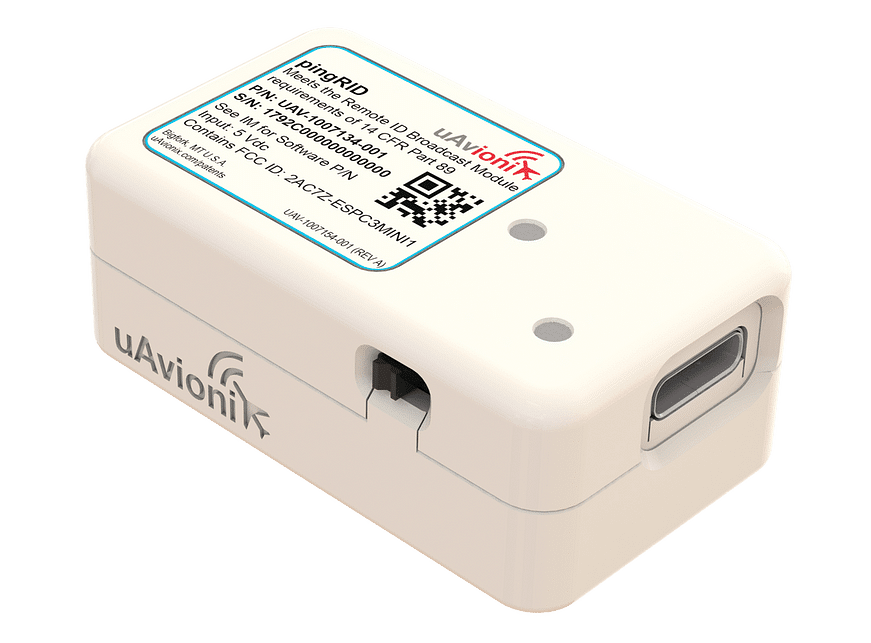This month, we are delighted to have Christian Ramsey from uAvionix share insights on an important change in drone regulations and how operators can remain compliant.
Christian Ramsey, Managing Director uAvionix Corporation

As the use of Unmanned Aircraft Systems (UAS) continues to increase, the Federal Aviation Administration (FAA) has introduced the UAS Remote Identification (RID) Rule to ensure airspace safety and security. The second and final part of this rule goes into effect in September 2023, requiring that UAS operators comply to facilitate their identification and tracking.
The first part went into effect in December 2022, and it required UAS manufacturers to include the technology in its products. This one-two punch is intended to ensure that all UAS equipment broadcasts its information, and that all UAS operators are using compliant equipment.
Let’s review what RID is and the ways to be compliant. The FAA’s Rule mandates that nearly all UAS operating in the U.S. comply using one of the following:
- Standard remote identification
- Broadcast modules
- FAA-recognized identification areas (FRIA).
Both standard RID and broadcast modules are technology-based transmitters that transmit the UAS location as well as the location of the operator (for standard RID) or takeoff location (for broadcast modules). FRIA compliance is location-based and allows for relief of the need to equip with the technology if flying in an FAA pre-approved location. Here’s a deeper dive into each:
Standard Remote ID
The FAA was very clever with its naming convention here, ensuring that the world knows that this option is intended to be the norm. Standard RID systems are what was required of manufacturers as of December 2022, and these solutions are built into the drones themselves. If you were to open your drone, you may not even be able to identify it.
One of the key differentiators of standard systems is that they are intended to be tamper-proof and cannot be turned off. They are so integrated into the drone that they will broadcast the operator’s GPS location, not just the aircraft’s location. As an aircraft manufacturer, you must submit a Declaration of Conformity (DoC) proving to the FAA that the system is installed and characterizing its performance. Only approved DoC’d aircraft are legal.
Broadcast Modules
A broadcast module is your retrofit solution. It is an entirely self-contained system that has no integration into the aircraft. Broadcast modules are often literally stuck-on to the aircraft with Velcro or some other kind of adhesive. Sometimes they contain a battery, but it is not required that they do so.
Instead of broadcasting the operator’s GPS location, broadcast modules can detect a takeoff and broadcast that location. From a security perspective, this is less reliable, and as such, there is a critical operational limitation with the use of broadcast modules—Beyond Visual Line of Sight (BVLOS) is not allowed. For that, you’ll need to upgrade to standard RID. Broadcast modules also need a filed and accepted DoC from the FAA. Buyer beware: Internet shopping sources reveal a significant amount of hardware on the market that does not have legal DoCs. uAvionix produces a broadcast module called pingRID.

uAvionix pingRID broadcast module
FAA-Recognized Identification Areas (FRIA)
A FRIA is a defined geographic area where drones can be flown without either standard RID or a broadcast module. Both the drone and the operator must be within the zone, and the aircraft must be within visual line of sight of the operator.
“Drone” here is used loosely because one of the primary reasons for a FRIA is to allow remote control (RC) aircraft enthusiasts to fly without RID technology, and generally, those aircraft are not referred to as “drones.” But if the aircraft does have standard RID onboard, you cannot turn it off legally while in a FRIA. There is an application process for being approved as a FRIA on the FAADroneZone website, but at the time of this writing, there have not been any sites approved yet.
Are There Exceptions?
Yes, there are a few exceptions, including:
- If your drone is less than 0.55 pounds and used only recreationally, you don’t need RID.
- Homebuilt UAS—defined as aircraft built by individuals solely for education or recreation—don’t need RID.
- If your drone is being flown in controlled airspace under Part 91 and under air traffic control services and equipped with ADS-B OUT, you don’t need RID. If you know what that means, you know. If you don’t know, you need RID.
- RID isn’t required for UAS of the U.S. Government. The rule does not say whether this means “owned by” or simply “operated by.”
- UAS designed or produced exclusively for the purpose of aeronautical research or to show compliance with regulations don’t need RID.
- You need RID “Unless otherwise authorized by the FAA Administrator.” The FAA usually has this language somewhere, giving them an out for special circumstances.
Currently, the uptake on UAS manufacturers implementing standard RID and approved broadcast modules is slow but climbing. As the FAA and industry ramp up education and communications leading to the September deadline, the use of RID is expected to rise dramatically. Within a few years, its use will be nearly universal.
One benefit of this technology may be for insurance providers to use the data generated by RID devices to manage risk and even tailor insurance products and pricing. Ultimately, having greater accountability within the drone community should improve overall risk characteristics.